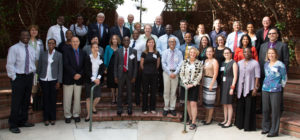The achievement of health goals laid out in major USAID initiatives, such as Ending Preventable Child and Maternal Deaths (EPCMD) and creating an AIDS-free Generation (AFG), is largely dependent on health-systems-strengthening (HSS) investments that create long-lasting improvements in health systems performance.
Robust measures are essential for gauging the impact of investments in strengthening a health system and its pharmaceutical sub-system. However, there is no standardized approach for measuring progress toward stronger, more resilient pharmaceutical systems. Furthermore, there is no widely accepted definition of what constitutes a pharmaceutical system—or what constitutes its “strengthening”. In the absence of clear definitions and of generally accepted reliable measures, countries and donors lack information to direct interventions and investments in strengthening pharmaceutical systems.

In September of 2014, the USAID-funded Systems for Improved Access to Pharmaceuticals and Services (SIAPS) Program convened a consultative meeting of its partners to identify definitions of a pharmaceutical system and pharmaceutical systems strengthening, and to define the key components to be included in a measurement framework for pharmaceutical systems strengthening. Participants, who represented 13 different organizations working to improve access and use of pharmaceuticals in low- and middle-income countries, included experts from USAID, the World Health Organization (WHO), represented by the Pan American Health Organization (PAHO), and from the Boston University School of Public Health.
Guided by a background discussion paper prepared by SIAPS, participants deliberated to reach agreement on definitions of a pharmaceutical system and pharmaceutical systems strengthening:
- A pharmaceutical system consists of all structures, people, resources, processes, and their interactions within the broader health system that aim to ensure equitable and timely access to safe, effective, quality pharmaceutical products and related services that promote their appropriate and cost-effective use to improve health outcomes.
- Pharmaceutical systems strengthening is the process of identifying and implementing strategies and actions that achieve coordinated and sustainable improvements in the critical components of a pharmaceutical system to enhance responsive and resilient system performance for achieving better health outcomes. The critical components of a pharmaceutical system are its core functions, structures, the supporting health system resources, and an enabling policy, legal, and governance framework.
Participants also identified the components to be included as part of a measurement framework for pharmaceutical systems strengthening. The key components identified were policy, law, and governance; regulatory systems; pharmaceutical products and services; human resources; financing; information; innovation, research and development, manufacturing, and trade. In addition, for each of these system components, participants proposed critical elements to guide SIAPS in the selection of indicators for its measurement framework.
The commitment and enthusiasm of the meeting participants to this consultative process played a key role in the meeting’s success. These results have laid a firm foundation for next steps, including the development of the measurement framework for pharmaceutical systems strengthening, and identifying and piloting indicators and tools that can be used to measure progress made in strengthening systems. These in turn will guide health system planners and donors that are considering investing scarce resources in ways that will have lasting results.

